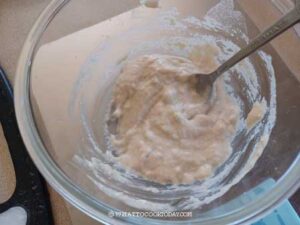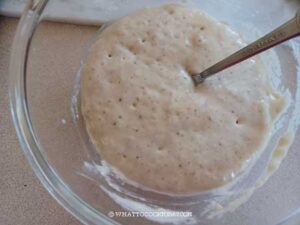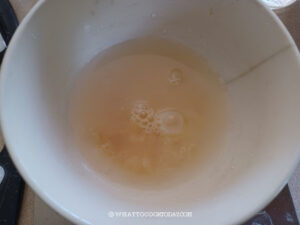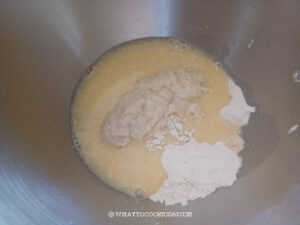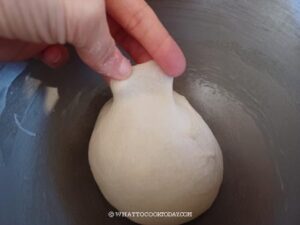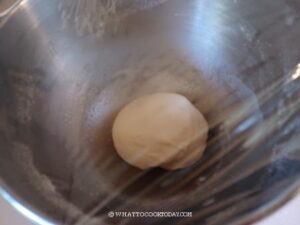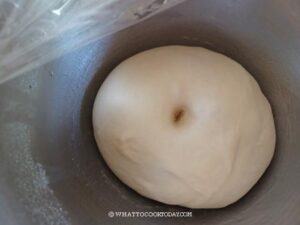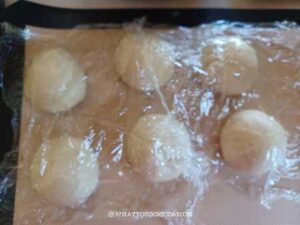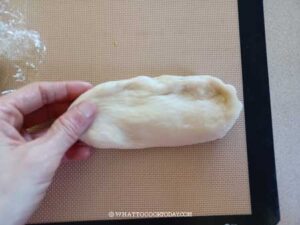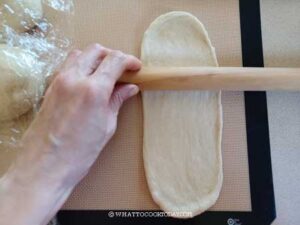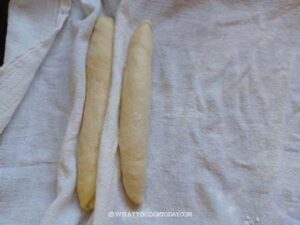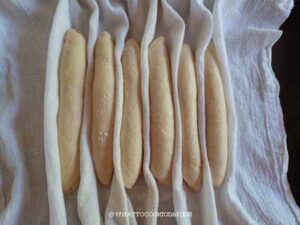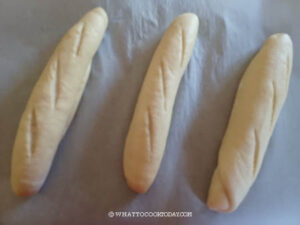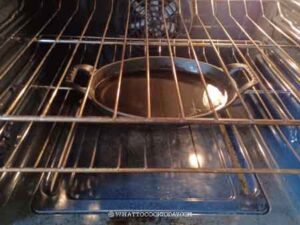This post may contain affiliate links. Please read our disclosure policy.
Learn how to make a Vietnamese-style baguette with a thin crust and spongy and fluffy crumbs. The method is quick and not complicated but produces really good Vietnamese baguettes. You can bake the baguettes without a special baguette pan.

I always thought I needed a special baguette pan to make baguettes and that’s why I didn’t make them until last year when I started making some without any pan with decent results. Of course, life will be easier if you have the pan, but if you don’t have any, you can still bake baguettes. You just need to improvise a bit.
Vietnamese baguette vs French baguette
Vietnamese baguette is an adaptation of the classic French baguette. Here are the key differences that I noticed:
1. Ingredients
Classic French baguette is made with only bread flour, yeast, water, and salt. The Vietnamese baguette has a bit of sugar, egg, a bit of milk, and oil added to the dough, so it is a bit more enriched compared to the classic lean French baguette
2. Shape
Classic French baguette is usually shaped longer and sider, whereas the Vietnamese baguette is thinner and shorter
3. Texture
Classic French baguette usually has a thicker crust and chewy crumbs. The Vietnamese baguette has a thin crisp crust with soft airy crumbs

Ingredients and substitutions
1. Bread flour
I use bread flour with 12.7% protein content
2. Instant yeast
I use SAF instant yeast. You can also use active dry yeast, but you need to bloom the yeast in the main dough with water first before adding to the rest of the ingredients
3. Egg
An egg is added for softer, creamier crumbs
4. Oil
You can use any neutral-tasting oil
5. Lemon juice
Lemon juice is added because the vitamin C in the juice helps to strengthen the gluten and also gives the loaf a better rise. Lime juice works too, though it has slightly lower vitamin C content compared to lemon juice, but it’s not a huge concern. here. Your bread won’t taste like lemons or limes in case you are wondering
6. Salt
I use fine sea salt. Besides taste, salt is also added to help control fermentation and to strengthen the dough
7. Sugar
Sugar is only used in very small quantities here. A little bit helps to boost the yeast activity. Since we use just a small amount, it’s not going to make a huge difference in terms of taste

Homemade Vietnamese Bánh mì Baguette
Ingredients
Preferment:
- ½ tsp sugar
- 30 g warm milk
- ⅓ tsp instant yeast
- 30 g bread flour (12.7% protein content)
Main dough:
- 225 g bread flour (12.7% protein content)
- ½ tsp salt
- ½ tsp sugar
- ¾ tsp instant yeast
Wet ingredients:
- ½ large egg
- 100 g water or more as needed
- 2 tsp oil
- ½ Tbsp lemon juice
For dusting:
Instructions
Prepare the preferment:
- Because I don't own a baguette pan, there are few things I need to prepare. I need a large linen cloth that is thick enough to help hold the shape of a baguette. If you have a couche, that would replace the baguette pan. I dust the cloth with some rice flour to prevent sticking (It works better than using bread flour)

- I also wrap a piece of sturdy cardboard with aluminum foil that I sprayed with some non-stick spray to transfer the dough from the cloth to the baking pan later
- Mix all ingredients for the starter in a mixing bowl of a stand mixer. I knead the dough using a stand mixer later on.

- Cover and let it proof for 30 minutes until the mixture is foamy and bubbly. It doubles in volume

- Combine all the wet ingredients and whisk it to combine

- Pour it into the mixing bowl of the stand mixer. Add the rest of the ingredients for the main dough to the same bowl. Use a dough hook to stir the mixture a bit so when you start the machine, the flour won't fly everywhere.

- Attach the dough hook attachment and start kneading the dough on low speed, speed 2 on my Kitchen Aid mixer, for about 10-15 minutes or until the dough clears the side of the bowl and is smooth, and elastic. If you gently stretch the dough thinly, it won't tear easily. The dough will be sticky to the touch and that's okay, we want it that way

First proofing:
- Pick up the dough and put it in a lightly oiled container to let it proof until it is double in volume at a warm place.

- This may take about 1 hour or longer, depending on the temperature where you are

- Knock out the gas from the dough by folding it several times and divide into 6 equal pieces of dough, roughly about 70 grams each. Roll each one into a round ball. Cover and let them rest for 10 minutes. This is to relax the gluten so we can shape the dough much easily

Shaping:
- Work with one dough at a time and keep the rest covered. Gently stretch the dough a bit with your hands

- Use a rolling pin to slowly roll it into about 28-30 cm long (11-12 inches long). The dough will shrink back a bit. If the dough keeps shrinking back when you try to roll it, just rest it for 5 minutes to relax the gluten and then roll again

- Then roll the dough on its length.

- Use your palms to roll the two ends so they are pointy

- Place the dough, seam side down, on the prepared cloth. Repeat with the rest of the dough.

- Raise the cloth in between the dough so it helps to maintain the shape of the dough and to prevent the dough from sticking to each other. I use two heavy objects to secure both left and right so they help to support the shape of the baguette

Final proofing:
- Proof the dough until they are really puffy, about 1 hour or so

- Prepared two baking pans, invert the bottom side of the pan up. So the baking pan is rimless. Line with parchment paper.
- Use a cardboard you make earlier to gently transfer the dough, one at a time, onto a baking pan.


- I put 3 doughs on each pan

- Use a bread lame or a very sharp razor to make three slashes at a diagonal on the surface of the dough. Mist the dough with water

Baking:
- 15 minutes before the end of baking, preheat the oven to 485 F (250 C) for conventional oven. For convection oven, lower the temperature by 20 F /15 C. Place a heat-proof pan at the bottom rack. Prepare about 1 cup of boiling water
- Bake one pan at a time. Place the pan on the middle rack and carefully pour the hot boiling water into the pan underneath it. This is to create steam.

- Quickly close the oven door. Reduce the temperature to 425 F (220 C) for conventional oven and lower the temperature by 20 F /15 C for convection oven and bake for 12-15 minutes or until they are golden brown and the internal temperature is at least 190 F (88 C)
- Remove from the oven and let them cool on a cooling rack completely
- Raise the temperature back up to 485 F (250 C) to bake the second batch. Prepare the boiling water again and repeat with the same process
How to store:
- Let the baguette cool down completely. Store them in a paper bag for a day or two. For longer storage, you can keep them in the freezer. Simply thaw and reheat before serving
RECOMMEDED TOOLS
*Nutrition facts are just estimates and calculated using online tools*
Did you make this homemade Vietnamese baguette recipe?
I love it when you guys snap a photo and tag it to show me what you’ve made. Simply tag me @WhatToCookToday #WhatToCookToday on Instagram and I’ll be sure to stop by and take a peek for real!


